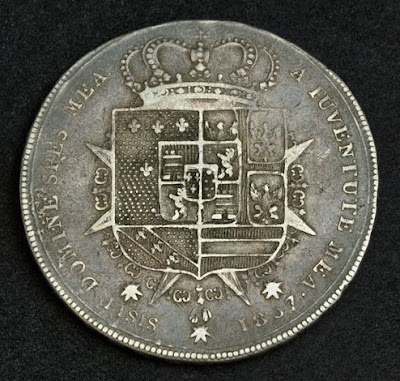 |
| Italian coins Tuscany Silver Francescone 10 Paoli |
 |
| Italian coins Tuscany Silver Francescone |
Italian coins, Italian Coinage, Italian silver coins, Numismatic Collection, Coins of Italy best silver coins for investment, Italian Gold Coins, Italian States Coins, Coins of Italy, Coins of the Papal States, Gold coins of Italy, Vatican Coins, Vatican Gold Coins, Italian colonial coins.
Obverse: Busts of Charles Louis (as ruler) and Maria Louisa (as regent) vis á vis.
Legend: CAROLVS . LVD . D . G . REX . ETR & M . ALOYSIA . R . RECTRIX I. I . H . H . (hammer) (PISIS monogram)
Reverse: Crowned multiple coat of arms with chain of the golden fleece around and three star orders hanging.
Legend: DOMINE SPES MEA - A IUVENTUTE MEA . / PISIS 1806
Comment: Royal spanish arms of Lion and Castille in inner shield
Mint Place: Pisa (Italy)
Denomination: Francescone (10 Paoli)
Reference: Davenport 152, KM-C50.1. R!
Region: Italian States, Tuscany (Kingdom)
Weight: 26.96 gram of Silver
Diameter: 41 mm
Tuscan pound
The pound (Italian: lira) was the distinct currency of Tuscany until the annexation by Napoleonic France in 1807. Ater that year, it unofficially remained in circulation thanks to its silver value until the restoration of Tuscan independence in 1814. It was finally abolished in 1826.It was subdivided into 20 shillings (Italian: soldo), each of 3 quattrini (singular: quattrino) or 12 pennies (Italian: denaro), with the paolo worth 40 quattrini and the francescone worth 10 paoli. It was replaced by the florin, worth 100 quattrini or 1⅔ pounds. In 1803 the pound contained 3.66 grams of silver.
In the late 18th century, copper coins circulated in denominations of 1 and 2 quattrini, and 1 shilling, together with billon 10 quattrini and silver ½, 1, 2, 5 and 10 paoli. In the early 19th century, copper ½ and 2 shillings were added, together with silver 1 and 10 pounds.
Charles II, Duke of Parma
Charles Louis of Bourbon-Parma (Carlo Ludovico di Borbone Parma) (22 December 1799 – 16 April 1883) was King of Etruria (1803–1807), Duke of Lucca (1824–1847), and Duke of Parma (1847–1849).He was the only son of Louis, Prince of Piacenza, and his wife Infanta Maria Luisa of Spain. Born at the Royal Palace of Madrid at the court of his maternal grandfather King Charles IV of Spain, he spent his first years living at the Spanish court. In 1801, by the Treaty of Aranjuez, Charles became Crown Prince of Etruria, a newly created kingdom formed from territories of the Grand Duchy of Tuscany. Charles moved to Italy with his parents and in 1803, not yet four years old, he succeeded his father as King of Etruria under the name Charles Louis I.
His mother Infanta Maria Luisa assumed the regency while Charles Louis minority lasted. In 1807 Napoleon Bonaparte dissolved the kingdom of Etruria and Charles Louis and his mother took refuge in Spain. In May 1808 they were forced to leave Spain by Napoleon who arrested Charles Louis' mother in a convent in Rome. Between 1811 and 1814 Charles Louis was placed under the care of his grandfather, the deposed King Charles IV of Spain.
After Napoleon's fall, in 1817, Infanta Maria Luisa became Duchess of Lucca in her own right and Charles Louis, age sixteen, became hereditary Prince of Lucca. In 1820 he married Princess Maria Teresa of Savoy. They were a mismatched couple and had only one surviving son.
At his mother's death in 1824, Charles Louis became the reigning Duke of Lucca as Charles I. He had little interest in ruling. He left the duchy in the hands of his ministers and spent most of his time traveling around Europe. A liberal movement led him to abdicate Lucca in favor of the Grand Duke of Tuscany in October 1847 in exchange for financial compensation, as he wanted to retire to private life. Two months later, in December 1847, at the death of the former Empress Marie Louise, he succeeded her as the reigning Duke of Parma according to what had been stipulated by the Congress of Vienna.
His reign in Parma as Duke Charles II was brief. He was ill received by his new subjects and within a few months he was ousted by a revolution. He regained control of Parma under the protection of Austrian troops, but finally abdicated in favor of his son Charles III on 14 March 1849. His son was assassinated in 1854 and his grandson Robert I, the last reigning Duke of Parma, was deposed in 1860. In exile Charles Louis assumed the title of count of Villafranca. He spent the last years of his life mostly in France, dying at Nice on 16 April 1883.